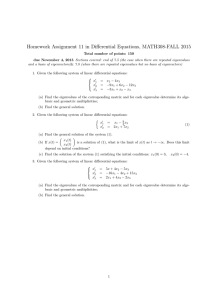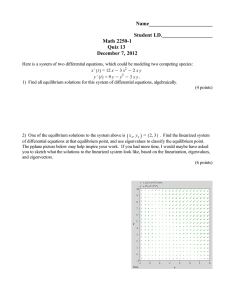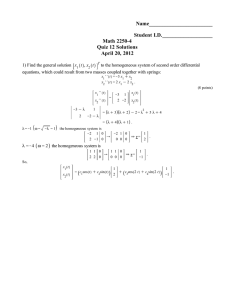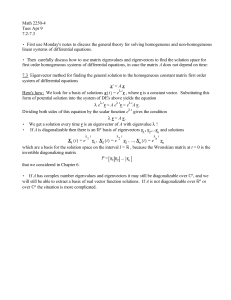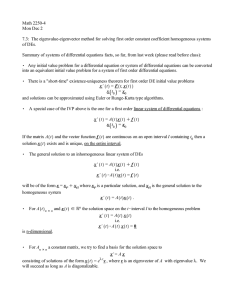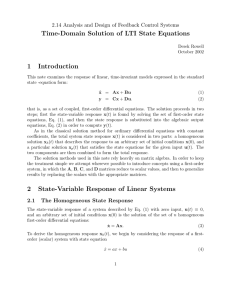Math 2250-4 Wed Nov 27 7.1-7.3 Finish Tuesday's notes:
advertisement
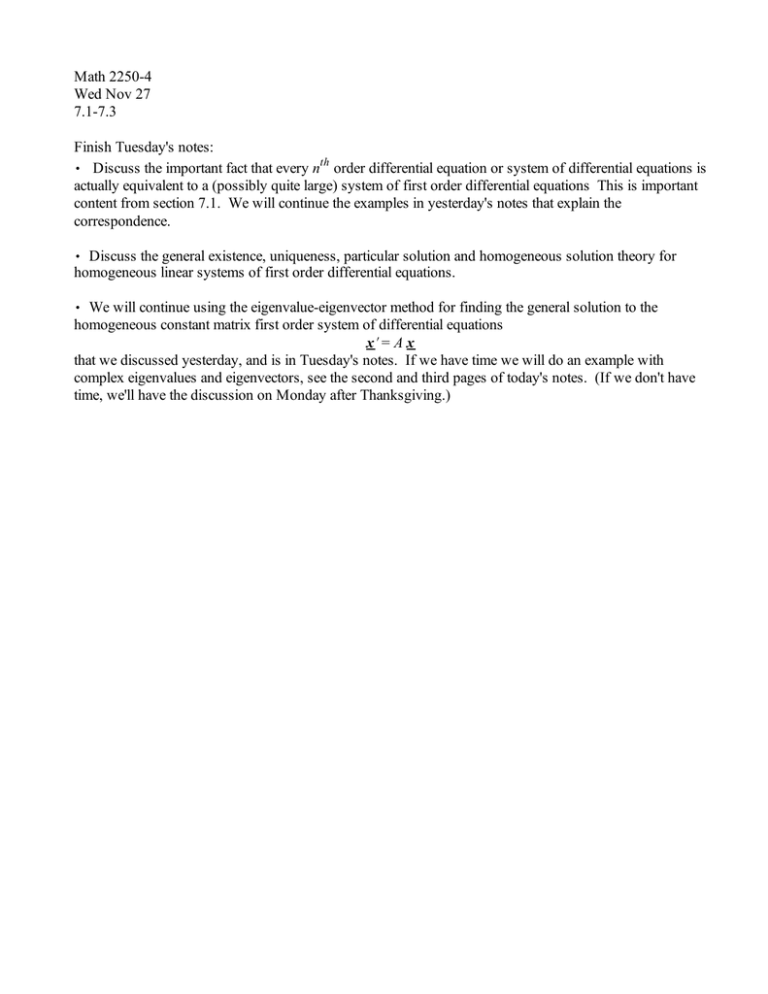
Math 2250-4 Wed Nov 27 7.1-7.3 Finish Tuesday's notes: , Discuss the important fact that every nth order differential equation or system of differential equations is actually equivalent to a (possibly quite large) system of first order differential equations This is important content from section 7.1. We will continue the examples in yesterday's notes that explain the correspondence. , Discuss the general existence, uniqueness, particular solution and homogeneous solution theory for homogeneous linear systems of first order differential equations. , We will continue using the eigenvalue-eigenvector method for finding the general solution to the homogeneous constant matrix first order system of differential equations x#= A x that we discussed yesterday, and is in Tuesday's notes. If we have time we will do an example with complex eigenvalues and eigenvectors, see the second and third pages of today's notes. (If we don't have time, we'll have the discussion on Monday after Thanksgiving.) So far we've not considered the possibility of complex eigenvalues and eigenvectors. Linear algebra theory works the same with complex number scalars and vectors - one can talk about complex vector spaces, linear combinations, span, linear independence, reduced row echelon form, determinant, dimension, basis, etc. Then the model space is Cn rather than =n . Definition: v 2 Cn (v s 0) is a complex eigenvector of the matrix A, with eigenvalue l 2 C if Av=lv. Just as before, you find the possibly complex eigenvalues by finding the roots of the characteristic polynomial A K l I . Then find the eigenspace bases by reducing the corresponding matrix (using complex scalars in the elementary row operations). The best way to see how to proceed in the case of complex eigenvalues/eigenvectors is to work an example. We can also refer to the general discussion on the following page, at appropriate stages. Exercise 3) Find the general solution to the following homogeneous system of DEs. Interpret your solution in terms of the pplane phase portrait shown below x1 # t x1 1 K2 = . 2 1 x2 x # t 2 Solutions to homogeneous linear systems of DE's when matrix has complex eigenvalues: x# t = A x Let A be a real number matrix. Let l = aCb i ∈ ℂ v = a C i b 2 Cn satisfy A v = l v , with a, b 2 =, a, b 2 =n . , Then z t = el t v is a complex solution to x# t = A x lt because z # t = le v and this is equal to A z = A el t v = el t A v . , But if we write z t in terms of its real and imaginary parts, z t =x t Ciy t then the equality z# t = A z 0 x# t C i y# t = A x t C i y t = A x t C i A y t . Equating the real and imaginary parts on each side yields x# t = A x t y# t = A y t i.e. the real and imaginary parts of the complex solution are each real solutions. , If A a C i b = a C b i a C i b then it is straightforward to check that A aKi b = aKb i aKi b . Thus the complex conjugate eigenvalue yields the complex conjugate eigenvector. The corresponding complex solution to the system of DEs e a K i b t aKi b = x t K i y t so yields the same two real solutions (except with a sign change on the second one).

